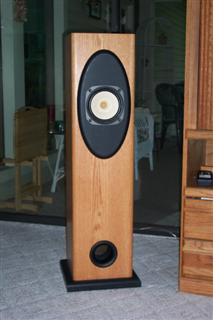
There has been a lot of discussion on the effacacy of phase plugs on some of the DIY forums. From that and at the earging of a couple of my customers, I contacted Dave Dlugos at Planet10-HiFi and asked for a pair of his phase plugs for evaluation. Dave kindly sent me a pair and I installed them in my demo model FT-1600 MkII speakers.
FT-1600 MkII with planet10-HiFi Phase Plugs
Close-up of the Modified Fostex FE167E
Modification of the FE167E is an easy matter of cutting out the dust cap with a razor knife and dropping the phase plug in the hole. The phase plug has two steel screws on the bottom and is held in position on the driver top plate by the magnetic force of the motor.
It would have been nice if I could have listened to the modified speakers before I ran the measurements, but it would have been rather inconvenient not to. The graphs below were made using Sound Easy with a Beringer EMC8000 microphone at 1 meter. The individual plots were then smoothed to 1/6 octave and nomalized to 0 dB at 1000 Hz. The graphs were produced using Speaker Workshop.


There are no remarkable differences below 2000 Hz. Just above that, the phase plugs move a minor dip for 2200 Hz up to 3000 Hz. This is an important region, and the effect is to add slightly to the presence of singers. The most impotent effect of the phase plugs, though is to put a hole in the 5000-7000 Hz range. This is were sibulance and breathiness occur. With the phase plugs in place, virtually all hints of sibulance in female voice disappear. Finally, the phase plugs reduce the level of the off-axis response above 3000 Hz, producing the effect of a generally falling response curve and softening the overall sound of the speaker.
So what do the speakers sound like now that they have phase plugs? The first impression was a loss of highs. Cymbals lost their sparkle, harpsichords lost their tinkle. But there was a new warmness to the sound that was intriguing. So, I let my ears burn in for a few days (earsburn in, speakersdo not!) and then gave the speakers another wringing-out. The speakers have a different sound now. Better? Worse? No, just different. The original voicing of the speakers was for Baroque orchestra and small-group jazz. The modified voicing is great for female voice. Alison Kraus and Diana Krall come off beautifully. Gong back to Carmigola's Vivaldi, the sound is somewhat less edgy with a mellowness that makes going through a couple of CD's in succession a pleasure.
One thing of note -- toe-in became critical in my listening room. The speakers are at the vertecies of an equilateral triange and toed-in 40o. Any less and the imaging suffers and the sweet spot goes to zero, any more and the sound stage collapses to the center.
If you have FE167E's in your speakers and you find them a bit too edgy and forward, seriously consider these phase plugs. I will offer the phase plugs as a "factory" option on all future FT-1600 and FB-16 speakers. They are a worth while modification.
A couple of caveats: This report applies to the Planet-10 phase plugs in Fostex FE167E's. Do not extrapolate this information to any other phase plugs or drivers. The results willbe different. Also, I don't feel that these particular phase plugs are optimized for this application. I would like to see the results of phase plugs of different lengths and different tip configurations. I am not in a position to do this kind of testing right now, but in the mean time, I endorse the Planet-10 phase plugs and again suggest that anyone with FE167E consider this modification.